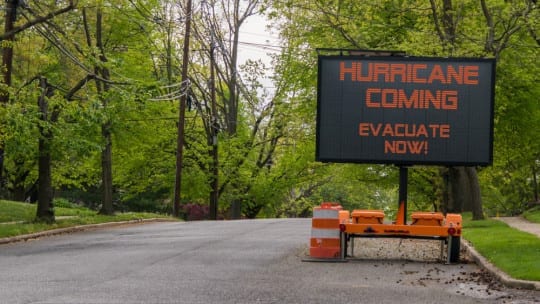
As Hurricane Florence stalks toward the U.S. Eastern seaboard, officials are urging residents of coastal North Carolina, South Carolina and Virginia to evacuate before the storm makes landfall on Thursday night.
But, as with all with major storms, some people just won’t listen. Communicators across government agencies and political offices must contend with skepticism, fear and just plain stubbornness from constituents when making announcements about hurricane preparedness and evacuation, even after the destruction of hurricanes like Katrina, Sandy and 2017’s trio of Harvey, Irma and Maria.
Evidence shows, however, that emergency management communications strategies concerning hurricanes have shifted significantly in recent years, leading to more accurate predictions and lower death tolls. But with weather events and natural disasters, there is a degree of uncertainty that makes this kind of messaging a delicate dance.
With Florence in particular, messaging has been particularly dire. Jeff Byard, Federal Emergency Management Agency associate administrator, said on Sept. 11, “This will be a storm that creates and causes massive damage to our country. It is going to be…a long-term recovery.” And North Carolina Gov. Roy Cooper told his constituents to expect prolonged power outages and to prepare evacuation routes now in order to “avoid losses due to Florence.”
The National Hurricane Center has been keeping followers informed on its Twitter feed, using language like “life-threatening” and “catastrophic” in relation to storm surges, flash flooding and hurricane-force winds in Florence’s wake.
Here are the Key Messages for the 5 AM EDT advisory for Hurricane #Florence pic.twitter.com/lY1y5KSZb9
— National Hurricane Center (@NHC_Atlantic) September 12, 2018
According to Cara L. Cuite, Ph.D., assistant extension specialist in the Department of Human Ecology at Rutgers University, fear has proven to be a great motivator when it comes to getting people to take hurricanes seriously. But this also requires balance.
“A certain amount of fear can be motivating,” Cuite told PR News, “but you don’t want to overstate it because then people think it’s just an overblown message and might be more likely to disregard what you’re saying. It’s doing it in a way that you’re being realistic and still encourages action.” Some compassion is also warranted—evacuation can be a stressful experience, especially if it means potentially losing one’s home.
Furthermore, Cuite cites research that shows that using words like “mandatory” evacuation, instead of “voluntary,” will implore more people to heed the warnings. But most states do not have a penalty associated with violating a mandatory order, so it can only be enforced to a certain extent, and there will always be outliers. Still, evacuation numbers are higher with the simple use of the word.
It’s worth noting too that often local communicators can have a larger impact on resident behavior than that of a larger government agency or politician, particularly if they have already established relationships with the people in the community. “When it comes down to the nitty gritty,” Cuite explained, “like is your neighborhood being asked to evacuate, that’s where the local emergency managers and other officials come in to help guide the residents.”
And when it comes to local communications, sometimes face-to-face interactions can be what makes the difference. “In some cases, it’s [emergency managers] going out and knocking door to door and letting people know that they need to go…sometimes it does take that level of engagement. The more people know you and the more that emergency management officials are a known entity in the community, the more persuasive they’ll be in terms of being able to help people.”
Obviously sometimes the in-person approach is not feasible, especially in larger communities and urban centers. But the changes in technology and the use of a multi-channel approach have made a huge impact on disaster preparedness communications. It’s no longer safe to assume everyone in an evacuation area will see warnings that appear on the evening news. Social media feeds are more vital than ever for getting the word out about storm paths and warnings. And communicators are making use text message alerts and other new technologies as well.
When asked if prior storms and the communications surrounding them have an impact on current behaviors, Cuite said yes. “Anecdotally, after Sandy, we talked to emergency managers who said, ‘We have some residents who evacuated and some residents who stayed, and when you talk to any of them, regardless of what they did, they say ‘well I’m never going to do that again.’”
Paradoxically, a person who survived a major hurricane and then took steps to fortify their home, may even be less likely to evacuate in the event of another disastrous storm since they’ve convinced themselves they’re now going to be safe.
Particularly now, though, as climate scientists warn that last year’s harrowing hurricane season is just the beginning, and recent reports of large death toll in Puerto Rico due to Maria have just come out in the past few weeks, it’s likely that more people than usual will evacuate for Florence. “I think it is easier for people to imagine death and destruction from a hurricane after seeing all of the images and all of the stories that came out last year, and are still coming out.”
Follow Hayley: @that_hayley
